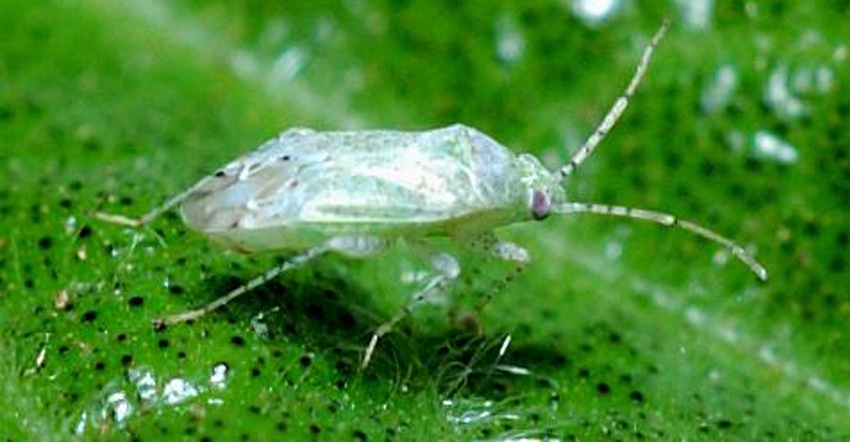
Throughout the eastern half of Texas, cotton fleahoppers (CFH) have been extremely bad this year, according to a state IPM coordinator.
"In the Brazos River Bottom, we have fields running 100 to 150 percent CFH infestation based on terminal inspections; the threshold is 10 to15 percent," says Professor and Statewide IPM Coordinator, Associate Department Head for Extension Programs Dr. David Kerns, in the June 13th Texas Row Crop newsletter. "These large populations are the result of ample rainfall and production of weedy hosts harboring CFH. The good news is CFH are easy to kill with the right insecticides. The bad news is the CFH are continually reinfesting sprayed cotton and we are not getting residual control out of our insecticides."
Commonly used insecticides targeting CFH include:
acephate at 4 oz/ac
imidacloprid at 2 fl-oz/ac
Centric at 1.5-2.0 oz/ac
Other less commonly used options include:
Intruder
Carbine
Bidrin
"Acephate is by far the most widely utilized insecticide for CFH. It is effective but has a very short residual," Kerns says.
When it comes to residual control, Kerns says some people like to up the acephate rate, but doing this helps very little for two reasons. "Firstly, even at high rates, acephate is short lived and secondly, the cotton plant puts on a new node about every three days and newly developed squares will have no insecticide protection. Thus under extreme CFH pressure, like we are currently experiencing, the best bet is to shorten your spray interval to five days until the pressure subsides, or we get into bloom and the risk from CFH injury subsides."
Another approach which may help but lacks data to fully endorse is to mix acephate at 4 oz/ac with imidacloprid at 2 fl-oz/ac, writes Kerns. "The theory is the acephate will provide the initial kill while imidacloprid (which is generally slow acting) will provide some residual activity through repellency. Hopefully, we will have better data on this approach from ongoing tests."
Kerns says they are picking up aphids, tarnished plant bugs, green stink bugs and bollworms. "This is the first year I have seen this many tarnished plant bugs this early, so be sure to be on the lookout for them. They act like CFH but will take larger squares and actually become more severe when we get into bloom. They are also much harder to kill than CFH."
Aphids are common and on pre-bloom to early bloom cotton. Kerns says he is seeing decent activity out of Sivanto at 5 fl-oz/ac, Centric at 2.0-2.5 oz/ac, and Intruder at 1.2 oz/ac. "Imidacloprid typically does not work due to resistance. Resistance to Centric is also common, and to Intruder to a lesser degree, so be sure to follow up treatment with these after three days to make sure they were effective. If you are treating tarnished plant bugs with Transform, using the Section 18 Emergency Exemption, and you have aphids in the field, Transform is highly effective on them as well."
But Kerns says, not to worry about stink bugs yet. "They will not do much until we start boll development, but bollworms are a different matter. Remember, our bollworms have demonstrated resistance to all Bt cotton except those with Vip. In non-Vip cotton, in areas where resistance has been as issue, we are recommending treating at 20 percent egg lay. In Vip cotton or any cotton in an area where Bt resistance has not been an issue, we recommend treating at 6 percent damaged squares or bolls with larvae present.
"Because many bollworms are resistant to pyrethroids, Prevathon 14-20 fl-oz and Besiege at 7.2-10.2 fl-oz are the favored products. These will provide two to three weeks of residual control depending on the rate. The higher the rate the longer the residual control. I am more inclined to use the higher rates. Do not treat again based on egg lay for two weeks."
CORN
In corn, most of what Kerns is seeing are corn earworms and "lots of them."
"Like in cotton, these are resistant to all Bt except those with Vip (Trecepta and Leptra). There is really nothing you can do about them in field corn that is economically effective; besides they usually do not take many viable kernels but feed primarily on the small kernel at the ear tip that will be expelled from the combine anyway. If you see corn earworm in Leptra or Trecepta corn, please let me know right away and we will collect them and test for Vip resistance."
Kerns says he will cover sorghum and soybeans in the next update. To receive his PestPatrol updates (which is a recorded alert you can get on your phone), register by texting the code word pestpat03 to the number 97063. Then reply confirmation by testing “y” to complete the registration.
For more information, contact Kerns at [email protected] or his cell (318) 439-4844.
About the Author(s)
You May Also Like






